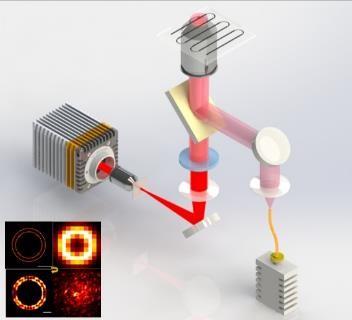December 12, 2019 -- Researchers from the Chinese Academy of Sciences describe a new unconventional super-resolution imaging, or nanoscopy, technique that processes nanometer resolution with fewer frames than traditional methods. This combinatorial process involves several processes to achieve super-resolution, overcome the diffraction of light, and capture changing dynamics with a faster technique.
The theory and experimental data of the single-frame wide-field microscopy technique were published on December 12, in Optica. "Our imaging method can potentially probe dynamics occurring on millisecond time-scales in subcellular structures with spatial resolution of tens of nanometers - the spatial and temporal resolution at which biological processes take place," said Zhongyang Wang, co-leader of the research team.
Combining imaging techniques
The current approach relies on stochastic optical reconstruction microscopy (STORM) to achieve super-resolution. It is a wide-field technique that uses fluorescent labels that switch between light-emitting (on) and dark (off) states. This technique is able to acquire hundreds or thousands of snapshots of labels at any given time, which are then used to reconstruct a complete fluorescent image.
In the current study, researchers added ghost imaging technique to speed STORM processes. Ghost imaging correlates a light pattern interacting with an object as referenced to a pattern that not interact with the object. Using a computational approach called compressive imaging, a reconstruction with fewer exposures is possible due to the use of an algorithm that fills in missing information.
Implementation of Single-frame wide-field nanoscopy
The researchers integrated STORM and ghost imaging with the use of an optical component known as a random phase modulator, which converts the fluorescence pattern of a STORM sample into a random speckle pattern. Next, the pattern is coding in a way that allows each pixel of a very fast CMOS camera to collect light intensity from the whole object as a single frame. Then a ghost image was generated by correlating the light intensity to a reference light pattern in a single step. The end result is efficient image acquisition and reduction in the number of frames required to form a high-resolution image.
"While STORM requires a low density of fluorescent labels and many image frames, our approach can create a high-resolution image using very few frames and a high density of fluorophores," said co-leader of research team Shensheng Han. "It also doesn't need any complex illumination, which helps reduce photobleaching and phototoxicity that could harm dynamic biological processes and living cells."
Nanoscopy validation

The team tested this microscopy technique by imaging a DNA origami ring, with just a 60-nanometer distance. The new approach resolved the ring using just 10 image frames while other traditional methods needed up to 4,000 frames to achieve the same super-resolution. Additionally, the new nanoscopy technique resolved a 40-nanometer ring in just 100 frames.
"We hope this method can be applied to a variety of fluorescent samples, including those that exhibit weaker fluorescence than those used in this research," said Wang. The researchers also want to make the technique faster to achieve video-rate imaging with a large field of view and plan to use it to acquire 3D and color images.
Do you have a unique perspective on your research related to bio-imaging? Contact the editor today to learn more.
Copyright © 2019 scienceboard.net


